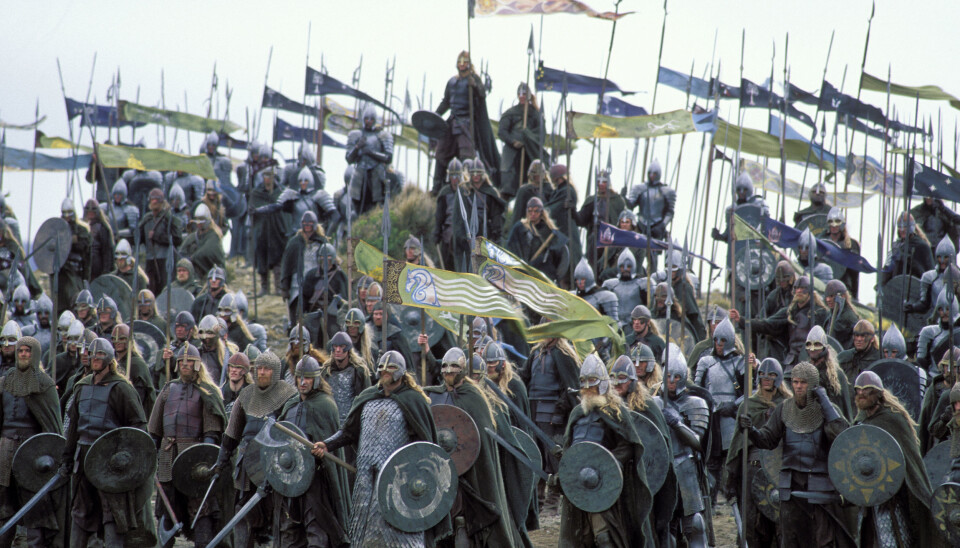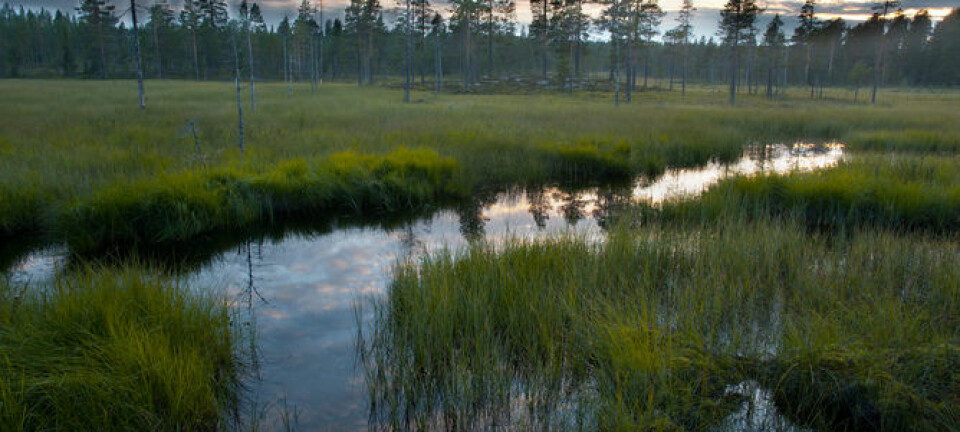This article was produced and financed by University of Stavanger

The names of Tolkien's universe explained
The works of J.R.R. Tolkien are an excellent introduction to Old English and other historic languages, according to a researcher.
“To me a name comes first and the story follows”, John Ronald Reuel, alias J. R. R. Tolkien writes in one of his letters, published in “The Letters of J. R. R. Tolkien”.
The naming of Tolkien’s characters is a story in its own right, as associate professor at the University of Stavanger Oliver M. Traxel points out.
“Tolkien was fascinated by names and saw it as a basis for his fiction. Therefore there is generally a deeper meaning to the names encountered in Middle-earth.”
Traxel, a specialist in Old English and English language history, considers the works of Tolkien an excellent introduction to Old English and other historic languages.
Below you can read more about the etymology behind some of the many names in Tolkiens vast universe.
Middle-earth
According to medieval sources, the Germanic tribes of the Angles, Saxons, Jutes and Frisians started invading Britain in 449 and eventually settled there. This event can be seen as the beginning of the Old English language.
This earliest version of English dominated most of the British Isles until it gradually changed into Middle English during the course of the twelfth century.
Tolkien was professor of Anglo-Saxon at the University of Oxford from 1925 to 1945 and therefore had a special relationship to the time period of Old English.
Even the name of Middle-earth itself can be traced back to this language stage.
“It is just a use of Middle English “middel-erde”, or “erthe”, altered from Old English “Middangeard”, the name for the inhabited lands of Men “between the seas””, as Tolkien explains in the same letter where he mentions his fascination with names.
“It is also related to Old Norse “Midgard”, Traxel adds.
Frodo and Samwise
“Just by looking at the names of the main Hobbit protagonists one is struck by the range of influences that can be discovered”, Traxel points out.
He starts off with Frodo Baggins, bearer of the One Ring through an inheritance from his uncle Bilbo Baggins in “The Lord of the Rings”. The name Frodo is inspired by Old English, where “frōd” means “wise”.
Gardener Samwise Gamgee is a friend of the Baggins family and Frodo’s companion.
“Samwise consists of two Old English elements, namely the prefix “sam–”, which in Old English means “half”, and an adjective with the same meaning as “frōd”.
“This combination is also attested in Old English. Tolkien merely modernized its second element, which in Old English would have been spelt “wis””, Traxel elaborates.
Bilbo
It is uncertain if the first name of Frodo’s uncle, the home-loving Hobbit Bilbo Baggins, contains any Old English.
“But there is a word “bil” which means “sword” and would provide a nice link to Bilbo’s sword “Sting”. As it tends to glow near Orcs, the element “–bo” might be seen as a shortened form of Old English “beorht” (“bright”)”, Oliver Traxel suggests.
A connection to the Spanish city Bilbao, which was once famous for its sword production, has also been put forth as explanation for the name Bilbo.
Peregrin and Merry
The names of two other well-known Hobbits come from different sources.
The first name of Frodo’s cousin and friend Peregrin Took, also known as “Pippin” or “Pip”, is derived from Latin “peregrinus” (“wanderer”), while his nickname “Pippin” is a frequently attested name among the Franks. The most well-known historical person is Pippin the Short, the first Carolingian king and father to the great medieval emperor Charlemagne.
A mythical figure, Conan Meriadoc, whose origins may go back to the fourth century, seems to be behind the name of the other important cousin and friend of Frodo’s, Meriadoc Brandybuck (Merry).
Conan Meriadoc is considered to be both the legendary founder of Brittany and ancestor of the real House of Rohan, which itself served as a name-giver for a region in Middle-earth.
Combination with extinct forms
Tolkien also combined modern forms with extinct forms, as seen, for example, in “Shelob”, the giant spider that dwells in the passes above Minas Morgul.
This name links the modern form of the third person singular feminine pronoun “she”, Old English “hēo”, with the Middle English spelling of Old English “lobbe” (“spider”).
Similarly, the name of the mighty horse “Shadowfax”, noted for its speed – “like an arrow”, consists of the modern spelling of Old English “sceadu” (“shadow”) and extinct “fax”. The word “fax” existed in Old and Middle English, where it meant “hair”, but it is also found in Old Norse and Tolkien used that meaning of the word (“mane”) for the name of the horse.
“Besides choosing names because of their literal meaning Tolkien could also pick them because he liked their sound”, Traxel says.
Gandálfr and other Old Norse influences
“In fact, the name of one of the first characters he created was taken from an Old English poem called “Christ I” or “Advent Lyrics”, namely “Eärendil” the Mariner.
In the Old English text, “ēarendel” refers to the Morning Star which proclaims the coming of Christ.
There are also other Germanic references to this name, such as Old Norse “Aurvandil”, which appears in the “Younger” or “Prose Edda” for a companion of the god Thor.
Another Old Norse text collection served as a particularly rich resource for Tolkien, namely the “Elder” or “Poetic Edda”; almost all names of his Dwarves are taken from stanzas 9-16 of the “Völuspá” (“The Seeress’ Vision”), a section also known as “Dvergatal” (“Counting of Dwarves”).
“In addition, it also contains the name “Gandálfr”, which can be translated as “staff-elf” and served as a name-giver for Gandalf, the most famous wizard in Middle-earth, though it was originally intended for the chief dwarf in “The Hobbit””, Traxel explains.
Composite names
Many Anglo-Saxon names consist of compounds, such as Beowulf (“bee-wolf”, “bear”) and Alfred (“elf-counsel”).
There are a great deal of examples for composite names in Rohan that can be explained by Old English, such as the name of the only son and heir of King Théoden of Rohan, Théodred. Théodred’s name probably comes from the Old English words “þēod” (“people”) and “rǣd” (“counsel”).
The Old English word for “horse” is “eoh”, and many names in Rohan begin with the derived form “Éo-”, such as “Éomer” (“horse-mare”) and “Éowyn” (“horse-joy”).
A particularly interesting case outside Rohan is Saruman the White, a wizard who seeks the One Ring for himself, Oliver Traxel points out.
“Saruman” can be translated as “skill-man”, where the Old English element “searu”, or “saru” in a dialectal form, can have either a positive or a negative connotation”, he explains.
Finally, many names were not inspired by historical texts or languages but are derived from Tolkien’s invented languages, in particular Elvish. A prominent example is “Legolas”, a Wood-elf form of the Sindarin word for “greenleaf”.
References:
Nagel, Rainer. Hobbit Place-Names: A Linguistic Excursion through the Shire. Zurich & Jena: Walking Tree, 2012.
Shippey, Tom. J. R. R. Tolkien: Author of the Century. London: HarperCollins, 2000.
Shippey, Tom. The Road to Middle-Earth: How J. R. R. Tolkien Created a New Mythology. Rev. and exp. ed. London: HarperCollins, 2005.
Tolkien. J. R. R. The Letters of J. R. R. Tolkien. No. 165. Ed. Humphrey Carpenter with the assistance of Christopher Tolkien. London: George Allan & Unwin, 1981.
Traxel, Oliver M. “Exploring the Linguistic Past through the Work(s) of J. R. R. Tolkien”. In Binding Them All: Interdisciplinary Perspectives on J. R. R. Tolkien and His Works. Ed. Monika Kirner-Ludwig, Stephan Köser & Sebastian Streitberger. Zurich & Jena: Walking Tree, 2017.
































